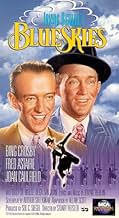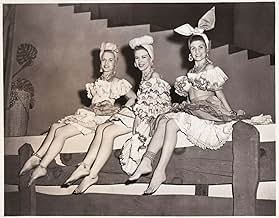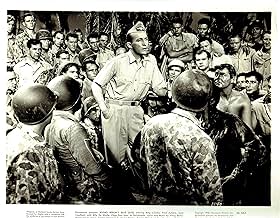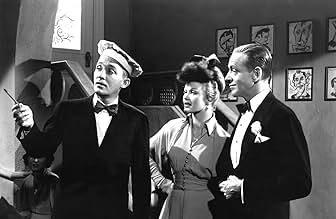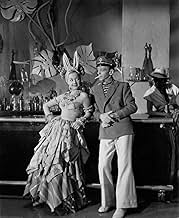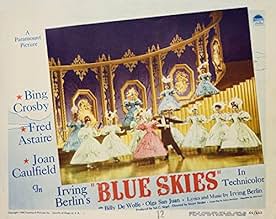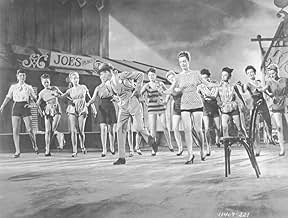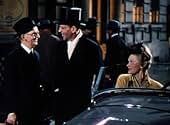अपनी भाषा में प्लॉट जोड़ेंAn ex-dancer and New York radio star narrates his love story for a band singer who loved a self-centered man who was unable to commit to his nightclub business or his family.An ex-dancer and New York radio star narrates his love story for a band singer who loved a self-centered man who was unable to commit to his nightclub business or his family.An ex-dancer and New York radio star narrates his love story for a band singer who loved a self-centered man who was unable to commit to his nightclub business or his family.
- निर्देशक
- लेखक
- स्टार
- 2 ऑस्कर के लिए नामांकित
- 3 जीत और कुल 3 नामांकन
- Dancer
- (बिना क्रेडिट के)
- Dolly
- (बिना क्रेडिट के)
- Dancer
- (बिना क्रेडिट के)
- Flapper
- (बिना क्रेडिट के)
- Dancer
- (बिना क्रेडिट के)
- Restaurant Patron
- (बिना क्रेडिट के)
- Dancer
- (बिना क्रेडिट के)
- Dancer
- (बिना क्रेडिट के)
- Showgirl
- (बिना क्रेडिट के)
फ़ीचर्ड समीक्षाएं
Astaire has three of his four dance numbers in the first half of the movie. One of them, "Puttin' On The Ritz," is one of the most impressive performances, if not THE best, he's ever done. It is absolutely spectacular. The movie is worth seeing for that performance alone. For the next hour, there is a romance gone sour and Crosby's crooning (some good songs, some bad).
The film's intent was to pay tribute to Irving Berlin and all the music he gave us, and it succeeds on that level. There are nothing but nice people in the movie and tons of music.....but the whole thing lacks something.
At any rate, here both male stars are in love with the same woman (Joan Caufield in this case). I like the pairing of Astaire and Crosby. Their respective talents play well off each other, especially in their "A Couple of Song and Dance Men" performance. There are so many songs that show up in Irving Berlin musicals that I didn't even realize were Irving Berlin songs. Crosby performs "(I'll See You in) C-U-B-A." I must say that I prefer Desi Arnaz' rendition. Crosby sang it too slow for my tastes. One of the supporting players, Billy deWolfe, was funny enough. However, I wasn't a fan of his shtick when he was performing sans Crosby or Astaire. He had one bit that went on for quite some time. He was portraying "Mrs. Murgatroyd." I was surprised that his routine was allowed to go on so long since it was just not that amusing. I did some research and found out that deWolfe was a popular comedian in the day and "Mrs. Murgatroyd" was one of his popular characters. Knowing that information, it put his performance into context and it helped make sense out of the attention his act is given in the film.
The showstopping number was Fred Astaire's "Puttin' on the Ritz" number. The rest of the film is average, but Astaire's number makes the entire film worth watching. It is fantastic and a complete joy to watch. The filming and special effects involved in this routine are excellent when considering the production date. There was also another rendition of "White Christmas" which is always enjoyable.
Oh, do notice that the lyrics to "Puttin on the Ritz", which was written for the 1930 film of the same name, have been changed to remove any perceived racial elements. The original lyrics talked about well dressed African American servants out on their night off. The version sung here mentions people who are "dressed up like a million dollar trouper trying hard to look like Gary Cooper". Not many people in 1930 would have known who Gary Cooper was. He was not a big star yet. At any rate, this film is where the change is first made.
I'd recommend it, but just don't expect "Holiday Inn".
I believe that this film shows the different "style" of the studios. Had this been made at M-G-M, if probably would have been great, at Paramount it falls flat. "Lady in the Dark" was another Paramount opus which had a similar fault.
The story of this love triangle is backed up by one Irving Berlin song after another - there is a lot of music, some fine singing by Crosby and tremendous dancing by Astaire. This was to be his last film but his retirement only lasted a couple of years. He worked in film until 1977 and continued working in television and doing voiceovers until 1981; he died in 1987. In the late '50s, he did two dance specials on television, and he did one in 1968. Was he dancing at the age of 69? Probably.
The movie doesn't really hang together. The production values are great, but the story is trite, and there aren't enough fabulous numbers. Astaire does "Puttin' on the Ritz," which is the height of the film, also "Heat Wave," and with Crosby, "A Couple of Song and Dance Men." There is a section during World War II where Crosby sings some of his Berlin standards, "This is the Army, Mr. Jones," "White Christmas," and "Any Bonds Today?" The beautiful "Always" is done as a chorus number, as is "How Deep is the Ocean," with Crosby sometimes singing along.
Having heard Crosby when he had something to prove back in the early '30s, I can never be content with his crooning, except perhaps in some parts of "Holiday Inn." Astaire is the one who makes this film worthwhile at all. See it for him and for some of the music and musical numbers. Ignore the story.
In common tradition to many 1940s movies, most commonly found in the "film noir" genre, BLUE SKIES is told in flashback, starting in modern day setting at a radio station, Broadcast Network of America in New York City's Rockefeller Center, where Jed Potter (Fred Astaire), a former dancer now a radio personality, relates his life story and career to his listeners, a story with a beginning but without a finish. Dating back circa 1919 following World War I finds Jed attracted to Mary O'Hara (Joan Caulfield), a girl, a "very pretty girl," working in the chorus. He invites her to accompany him for dinner at a night club owned by Johnny Aams (Bing Crosby), his Army buddy. Almost immediately, Mary is attracted to Johnny, but in spite of Jed's warning that Johnny is not the marrying kind, she cannot resist him. Johnny and Mary marry, and during their union have a daughter, Mary Elizabeth (Karolyn Grimes). All goes well until Mary finds that Jed is right in his assumption of Johnny being selfish and unstable, buying and selling nightclubs (oneof them called "Top Hat") at a moment's notice, and unable to settle down at in one place they could call home. After their divorce, Mary becomes engaged to Jed. Finding she's unable to marry Jed, Mary disappears, leaving Johnny as well as Jed, through his narration, to wonder whatever became of her.
As Jed Potter relates his "album of Irving Berlin songs" to his radio listeners, movie viewers get to to be treated to see and hear such classic tunes including: "A Pretty Girl is Like a Melody" (sung by chorus, danced by Fred Astaire); "I've Got My Captain Watching for Me Now" (Sung by Bing Crosby); "You'd Be Surprised" (sung by Olga San Juan); "All By Myself" (Crosby); "Serenade to an Old-Fashioned Girl" (sung by Joan Caulfield); "Puttin' on the Ritz" (Astaire); "I'll See You in C.U.B.A." (Crosby); "A Couple of Song and Dance Men" (Astaire and Crosby); "You Keep Coming Back Like a Song" (Crosby); "Always" (chorus); "Blue Skies," "The Little Things in Life," "Not for All the Rice in China" (all sung by Crosby); "Russian Lullaby" (Chorus); "Everybody Step" (Crosby); "How Deep is the Ocean" (chorus); "Running Around in Circles" (Crosby); "Heat Wave" (sung by Olga San Juan/danced by Astaire); "Buy Bonds Today" "This is the Army" "White Christmas" and "You Keep Coming Back Like a Song" (all sung by Crosby). "Mandy" and "Some Sunny Day" are those other songs heard as background music.
Astaire's "Puttin' on the Ritz" number, where he dances to eight images of himself, is one of the great highlights. First introduced by Harry Richman for the 1930 musical, PUTTIN' ON THE RITZ, the original lyrics have been changed to fit the Astaire style as well as the changing of times. Crosby and Astaire also provide fine moments with their joint collaboration as "A Couple of Song and Dance Men." Billy De Wolfe supplies much of the comedy relief as Johnny's partner and assistant. Aside from being the love interest to Olga San Juan, he does a five minute one man comedy routine as Mrs. Murgatroyd.
While the story tends to get corny at times, it does get better with its passage of time and its assortment of fine songs. Aside from Crosby's singing, his sentimental moment where he meets with his little girl (Grimes) again is well done, along with Astaire's dancing, which is always first rate. He briefly breaks away from his traditional character where he becomes a troubled dancer who turns to liquor after being jilted. Legend has it that BLUE SKIES was originally intended to become Astaire's farewell movie. Fortunately, after his two year retirement, he was lured back to the screen for more musicals, dramas and everything else through 1981. Joan Caulfield, then new to the movies, would work again with Crosby in WELCOME STRANGER (1947), an underrated drama with songs. Crosby and Astaire wouldn't work together again until being reunited again for their TV special, "A Couple of Song and Dance Men" (CBS, 1974)
Formerly presented on American Movie Classics (1994-1999) and later Turner Classic Movies (where it premiered February 18, 2007), BLUE SKIES, distributed on video cassette in 1997, is also available on a DVD package double featured with Crosby's other musical, BIRTH OF THE BLUES (1941). Although BLUE SKIES is not as memorable as HOLIDAY INN, they can be summed up as being two different movies with similar storyline as well as the memory of all that. (***1/2)
क्या आपको पता है
- ट्रिवियाAfter Fred Astaire announced his retirement before completing this film, New York's Paramount Theater generated a petition of 10,000 names to persuade him to come out of retirement.
- गूफ़At the beginning of the movie, which is just after World War I, the Crosby character tells the De Wolfe character to do his Frankenstein routine. The Frankenstein character he does is based on Boris Karloff's 1931 version which some ten years or so in the future. At that time in the movie Frankenstein was just a creature in Mary Shelly's book.
- भाव
Jed Potter: Song and Dance Man.
Johnny Adams: Song and Dance Man, that's right.
Jed Potter: He didn't remember it then, how could he know it now?
Johnny Adams: Oh, get out, I bet I could do it right now, the whole thing.
- कनेक्शनFeatured in The Dick Cavett Show: Fred Astaire (1970)
- साउंडट्रैकA Pretty Girl Is Like a Melody
Words and Music by Irving Berlin (1919)
Sung by Fred Astaire
Danced by Fred Astaire, Joan Caulfield, chorus
टॉप पसंद
- How long is Blue Skies?Alexa द्वारा संचालित
विवरण
बॉक्स ऑफ़िस
- बजट
- $30,00,000(अनुमानित)
- चलने की अवधि
- 1 घं 39 मि(99 min)
- पक्ष अनुपात
- 1.37 : 1


